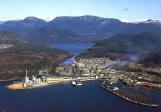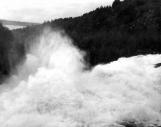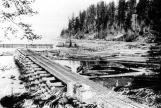1
An aerial view of the Powell River mill and Townsite taken in the late 1980's. Since then, the woodmill has disappeared as well as the grinder rooms, No. 1 through 8 paper machines and No. 1 Steam Plant. By the first decade of the 21st century the log pond became void of logs as modern technology and economic times caught up with the mill. The Kraft Mill is now shut down and the only pulp produced locally is from the Thermal Mechanical Pulp section.3
First there was Teshquoit, -- Place of Falling Waters and Rocky Canyon. Then in 1881 Captain Orelebar, commanding His Majesty's Frigate Rocket on a coastal survey trip named the river Powell River after Colonel Israel Powell, Superintendent for Indian Affairs in B.C., who was a passenger on the ship at the time.In 1893, Alfred Carmichael, of Victoria, B.C. was commissioned to make a survey of possible water sites for a paper mill on the coast and in 1898, following Carmichael's survey, Powell River, the centre of a great softwood area was recommended as an ideal place for a paper mill. It was a water power site waiting to be developed.
With the idea of encouraging industrial development in the province, the B.C. Government issued 21-year pulp leases in 1901. The Canadian Industrial Company purchased the Powell River leases.
In 1908 a paper mill in B.C. was deemed a risky pioneering venture: the population was small; political conditions were unsettled; major markets were far away and there was no Panama Canal. But Dwight and Anson Brooks, with M.J. Scanlon, saw possibilities. Brooks and Scanlon had operated a large sawmill in Minnesota since 1901. They purchased the 134,551-acre leases held by the Canadian Industrial Company with an initial capital of $1 million-quite a lot of money in 1908. Up to that time, half-hearted attempts to start pulp mills had been made at Port Melon and Swanson Bay. Pulp was actually produced at Swanson Bay in 1910, but the mill closed down after intermittent operations over a six-month period.
The Brooks Scanlon interests were logging in the Stillwater area, 13 miles south of Powell River. Dr. Brooks and M.J. Scanlon recognized the potential of the Powell River and lake system as a power site. Loggers were already on the scene-the Michigan and Puget Sound Company's railroad ran through what is now the Powell River Townsite. Dr. Brooks and his associate secured power rights at Powell River in 1910. Later in that year, construction workers were on the job, clearing the stumps left by loggers and slashing away the thick growth of small timber on the proposed paper mill site. A portable sawmill was installed to cut the trees cleared from the mill site into lumber for construction. The Michigan & Puget Sound railroad, which had been dumping logs at the beach in front of the property, had to be rerouted to Michigan Landing (new Willingdon Beach).
For over half a century the mill at Powell River continued to grow, sometimes slowly, sometimes rapidly. Then, over another half century it declined both as a supplier of pulp and paper to the world and as an employer of local people.
By the first decade of the 21st century the log pond became void of logs, technology and economic times caught up with the mill. Eight of the eleven paper machines were shut down, sold off or scrapped. The Kraft Mill was shut down and the only paper produced locally was from the Thermal Mechanical Pulp unit. Newsprint was no longer produced as the machines were switched over to other grades of paper.
4
Camp at Powell River1898
Powell River, British Columbia, Canada
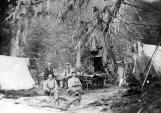 Credits:
Credits:P03044
A. Carmichael, photographer
5
The lower falls of the Powell River undoubtedly alerted the discovery team to the presence of a potential source of energy for the location of a pulp and paper mill.6
Lower falls at the Powell RiverCirca 1910
Powell River, British Columbia, Canada
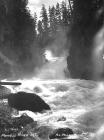 Credits:
Credits:P02790
R.L. Pocock, photographer
7
A visit to the upper falls of the Powell River confirmed a huge source of energy for the operation of a pulp and paper mill. This scene disappeared forever upon the completion of the dam across the Powell River.9
In 1910 a group of businessmen formed the Powell River Company. Rod LeMay photographed a pile driver beginning the construction of the first wharf, and the story of the growth of the mill at Powell River and the jobs that grew, changed and disappeared began.11
Building supplies and materials can be seen on the ground. The construction in the background appears to be part of the dam/forebay/penstock project.12
Early days at the mill siteCirca 1909
Powell River, British Columbia, Canada
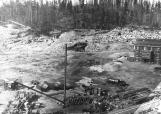 Credits:
Credits:P03021
Rod LeMay, photographer
Provincial Archives, Victoria, B.C.
13
An early view of the town site as it was being first cleared in 1910. A camp can be seen on the waterfront, as well as the log crib dam.14
Clearing for the Townsite1910
Powell River, British Columbia, Canada
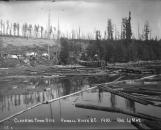 Credits:
Credits:A28-7-1
Rod LeMay, photographer
